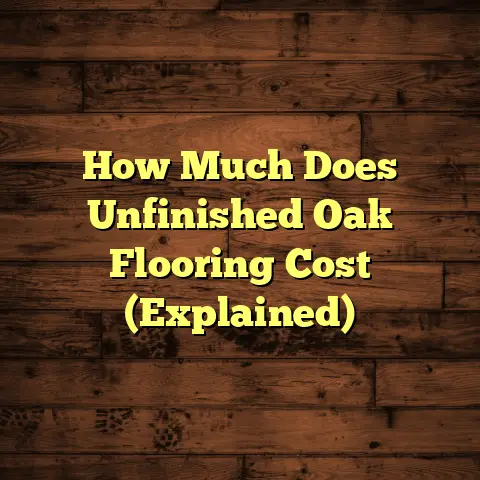Why Does My Wood Floor Make Cracking Noises? (Explained)
I remember the first time I heard that ominous crack from my wood floor.
It was a quiet afternoon, and I was sitting in my living room, sipping coffee and enjoying a book.
Suddenly, as I shifted my weight, a loud crack echoed through the room.
My heart raced.
Was my floor collapsing?
As a flooring contractor with years of experience under my belt, I knew better than to panic, but that sound sparked a journey into understanding what causes wood floors to make those unsettling noises.
If you’ve ever wondered why your lovely hardwood or engineered wood floor has developed a personality of its own with those cracks and pops, you’re not alone.
Let’s explore this topic together.
What Causes Cracking Noises?
Moisture and Humidity
One of the biggest culprits behind cracking noises is moisture.
Wood is a naturally hygroscopic material, which means it absorbs and releases moisture depending on the environment.
When humidity levels rise, the wood expands, and when they drop, it contracts.
This cycle can cause gaps and creaks.
I once worked on a project in a coastal area where the humidity was consistently high.
The homeowner noticed that their floor made cracking noises whenever they turned on the air conditioning.
After some investigation, we realized that the sudden drop in humidity caused the wood to contract rapidly, leading to those unsettling sounds.
The Science of Wood and Moisture
Understanding how wood behaves with moisture is crucial for homeowners.
Wood typically contains about 6% to 8% moisture when it is properly acclimated to indoor conditions.
However, in areas with high humidity, this level can rise significantly, causing the wood fibers to swell.
Conversely, during dry seasons or when heating systems are in use, the moisture content can drop below ideal levels, leading to shrinkage.
This fluctuation can cause several types of noises:
- Creaks: These occur as the floorboards rub against each other.
- Pops: Often a result of joints shifting due to changes in width.
- Clicks: These can happen when a floorboard moves against an unyielding surface.
During my years in flooring, I’ve learned that keeping humidity levels consistent—ideally between 30% and 50%—can greatly reduce these noises.
Installation Issues
Improper installation can also lead to cracking noises.
If the flooring wasn’t installed correctly—say, not enough expansion gaps were left around the edges—then as the wood expands and contracts, it can rub against itself or the subfloor, causing noise.
On one occasion, I was called to fix a floor that had been installed by another contractor.
The homeowner complained about persistent cracking noises.
Upon inspection, I found that the flooring had been laid too tightly against the walls without any room to expand.
It was an easy fix but required a complete rework of the perimeter.
Common Installation Mistakes
Here are some common mistakes during installation that can lead to noise issues:
- Insufficient Expansion Gaps: Not leaving enough space around walls and fixed objects can prevent proper movement.
- Incorrect Fastening: Over-tightening screws or nails can lead to buckling.
- Poor Subfloor Preparation: An uneven or loose subfloor can cause instability.
By examining these factors closely during installation, I ensure that noise issues are minimized from the start.
Temperature Changes
Temperature fluctuations can have a similar effect on wood floors as humidity changes.
In winter, when heating systems dry out the air, wood floors tend to shrink and create gaps.
This can lead to creaks when someone walks over them.
I remember a winter project where the homeowners were thrilled with their new hardwood floors.
However, as temperatures dropped outside and heating kicked in indoors, they began to hear creaks every time they walked across the living room.
It was a learning moment for me to remind clients about seasonal changes and their impact on wood flooring.
Seasonal Changes and Their Impacts
Understanding how seasonal changes affect wood floors is essential for homeowners:
- Winter: As indoor heating increases, humidity levels often drop, leading to contraction.
- Summer: High humidity can cause expansion and potential cupping of boards.
- Transitions: Areas where temperature changes frequently, like near doorways or windows, can be more susceptible to noise.
Maintaining a stable temperature throughout your home can help mitigate these effects.
Consider using programmable thermostats that keep temperatures consistent.
Subfloor Movement
Another factor contributing to noise is the movement of the subfloor beneath your wood flooring.
If the subfloor is not adequately secured or if it’s made from materials that shift over time, it can create a foundation for noise.
During one of my jobs in an older home, I discovered that the subfloor was not properly fastened down.
Every step on the hardwood created a sound as it moved slightly over the unsecured subfloor.
We ended up reinforcing the subfloor, which significantly reduced the noise.
Identifying Subfloor Issues
To identify subfloor issues:
- Inspect for Movement: Walk around the room and listen for squeaks or creaks in specific areas.
- Check for Loose Fasteners: A quick inspection can reveal if screws or nails have become loose over time.
- Assess Material Integrity: Older plywood or OSB may need replacement if they have deteriorated.
Addressing these concerns can lead to a quieter and more stable flooring experience.
Solutions for Cracking Noises
Proper Humidity Control
To mitigate moisture-related issues, maintaining a consistent humidity level in your home is vital.
A humidifier can help during dry months, while dehumidifiers are great for humid summer days.
I often recommend clients install these devices to protect their wood floors.
Humidity Monitoring
Investing in a hygrometer allows homeowners to monitor indoor humidity levels easily.
If you notice fluctuations outside of the ideal range, taking steps to adjust humidity can help prevent further issues.
Correct Installation Techniques
Choosing an experienced contractor for installation is key.
Make sure they leave adequate expansion gaps around walls and obstacles when installing your flooring.
I always measure carefully and ensure there’s room for movement.
Steps for Proper Installation
- Acclimate Flooring: Allow wood planks to sit in the room for several days before installation.
- Use Spacers: When laying down planks, use spacers at edges to maintain gaps.
- Secure Subfloor: Ensure that the subfloor is stable and free from movement before laying down hardwood.
By following these techniques, you can significantly reduce noise issues arising from installation mistakes.
Seasonal Maintenance
Encouraging homeowners to perform seasonal checks on their floors can go a long way.
For instance, if you notice creaking during winter, it might be time to adjust your heating system or invest in a humidifier.
Seasonal Checklists
- Winter Prep: Ensure humidity levels are adequate; consider running a humidifier.
- Summer Inspection: Check for signs of warping or cupping due to high moisture.
- Regular Cleaning: Keep floors clean and free from debris that might cause scratches or further noise.
Keeping a seasonal checklist helps maintain your flooring’s integrity throughout the year.
Reinforcing Subflooring
If you suspect that your subfloor is the source of noise, consider reinforcing it.
I’ve had great success using additional screws or installing plywood sheets to create a more stable base for hardwood flooring.
Steps to Reinforce Subfloor
- Identify Problem Areas: Walk around and mark squeaky spots.
- Add Screws: Use decking screws to secure loose areas back down.
- Install Plywood Sheets: If necessary, lay down 1/2” plywood over existing subfloor for added stability.
This approach not only reduces noise but also enhances overall floor stability.
Using FloorTally for Cost Estimates
When working on flooring projects, having accurate cost estimates helps manage expectations and budgets effectively.
I utilize FloorTally for this purpose.
The platform pulls local material and labor rates, allowing me to provide clients with realistic budgets right from the start.
For example, when I was working on a large renovation project that involved multiple rooms, FloorTally helped me streamline all calculations into one comprehensive estimate.
Instead of juggling between spreadsheets and quotes from various suppliers, everything was consolidated within one tool.
This made it easier to present options and discuss costs transparently with clients.
Benefits of Using FloorTally
- Time Efficiency: Saves hours by consolidating data into one platform.
- Accurate Estimates: Provides real-time pricing based on local rates.
- Visual Presentation: Allows clients to see options side by side for informed decisions.
- Detailed Reporting: Generates comprehensive reports that cover all aspects of installation costs.
By utilizing FloorTally in my projects, I’ve found it simplifies discussions with clients about budgeting and expectations significantly.
Personal Insights and Experiences
Throughout my years in the industry, I’ve encountered various challenges related to wood floor noises.
One memorable project involved an old Victorian home where every step made a sound like popcorn popping!
After inspecting the floors and realizing that they were simply resting on an uneven subfloor, I recommended refinishing them after leveling out the base.
On another occasion, I assisted a client who had just installed their wood flooring but was frustrated by persistent cracking noises.
After identifying proper humidity control as the issue, we set up a plan to monitor indoor conditions regularly.
Learning from Challenges
Every project presents its own set of challenges:
- Old Homes vs New Builds: Older homes often have more issues due to settling and age.
- Client Education: Sometimes clients need education about maintaining their flooring post-installation.
- Unexpected Costs: Hidden issues like mold or pests behind walls always add complexity.
These experiences shaped my approach toward future projects and reinforced the importance of thorough inspections before starting any work.
Practical Tips for Homeowners
- Monitor Humidity: Invest in a hygrometer to keep track of moisture levels.
- Choose Quality Materials: Opt for well-manufactured flooring with better resistance to movement.
- Engage Professionals: Always work with experienced contractors who understand wood flooring dynamics.
- Regular Maintenance: Schedule periodic checks on your flooring condition and address any issues promptly.
- Educate Yourself: Understanding how your flooring works will help you maintain it better in the long run.
Conclusion: Addressing Cracking Noises in Wood Floors
If your wood floor is making cracking noises, you’re not alone—many homeowners face this issue at some point.
Understanding the causes behind these sounds can help you take proactive measures to address them effectively.
From managing humidity levels to ensuring proper installation techniques and maintaining your subflooring, there are several ways to tackle this problem head-on.
Remember that regular maintenance is important; addressing minor issues before they escalate can save you time and money down the line.
By sharing my experiences and insights into common flooring issues like these, I hope you feel more empowered to keep your wood floors looking and sounding their best.
So next time you hear a crack underfoot, don’t panic—take a moment to assess what might be causing it and how you can address it!
Exploring More About Wood Floor Noises
The Impact of Foot Traffic
Another interesting aspect I’ve observed is how foot traffic affects wood floors over time.
The frequency of use can wear down certain areas more than others, leading to inconsistencies in sound production.
In busy households with children or pets running around constantly, certain planks may start showing signs of wear faster than others.
This uneven wear can contribute to creaking or cracking noises as some boards settle differently than others.
Tips for Managing Foot Traffic Impact
- Area Rugs: Place rugs in high-traffic areas to minimize wear on flooring.
- Shoe Policy: Encourage family members and guests to remove shoes upon entering.
- Regular Maintenance: Schedule periodic refinishing every few years based on usage patterns.
The Role of Furniture Placement
Have you ever considered how furniture placement affects your wood flooring?
Heavy furniture can create pressure points on your floors that lead to noise over time as well.
In one instance, I visited a client who had recently rearranged their living room furniture only to discover new creaks appearing where none existed before!
After assessing the situation, we found that heavy pieces were placed directly over certain planks without any support underneath them.
Recommendations for Furniture Placement
- Use Coasters or Pads: Place felt pads under furniture legs to reduce pressure on floorboards.
- Avoid Overloading Areas: Distribute weight evenly across rooms rather than concentrating it in one spot.
- Regularly Rotate Furniture: Change furniture placement periodically to avoid permanent indentation or pressure points.
Environmental Considerations
As we continue discussing wood floors’ behavior regarding noise production, it’s worth mentioning environmental factors beyond just humidity and temperature changes—like natural disasters or shifting earth movements!
I once worked with homeowners whose area experienced small earthquakes rarely but often enough!
We noticed their floors creaked significantly more after such events as shifting beneath them could cause previously stable boards to move slightly out of alignment.
In such cases:
- Regular Inspections Post-Event: Check floors after natural events like earthquakes or floods for potential damage.
- Consider Upgrades: Look into more resilient flooring options if you live in an area prone to natural disturbances.
Final Thoughts on Wood Floors
Wood floors bring warmth and character into our homes but require attention when it comes down noise concerns associated with them over time!
By understanding common causes—from moisture levels down through life activities like foot traffic—homeowners can better manage their spaces while enjoying all benefits hardwood offers!
So next time cracks echo through your rooms after stepping across those beautiful planks?
Just remember there’s always something worth investigating beneath those sounds!
With knowledge gained here today—and perhaps assistance from reliable tools like FloorTally—you’ll be well-equipped tackle any sound-related challenges ahead!





